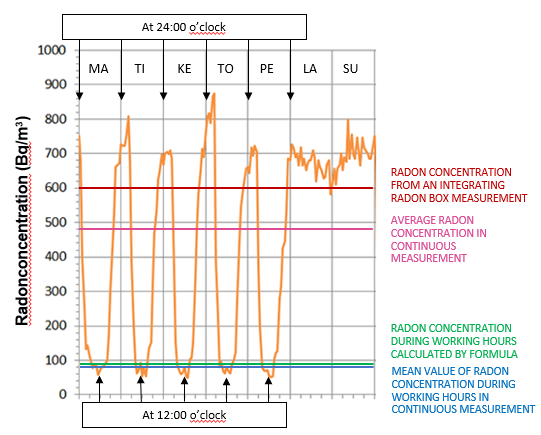Radon concentration during working hours
In workplaces, ventilation is often scheduled according to working hours, for example at nights and weekends, ventilation is set at a lower level or switched off completely. In this case, radon levels tend to increase at night and on weekends. This does not increase the radon exposure of workers, if the premises are not occupied during these times. When the ventilation is adjusted back to working hours, it usually takes two to three hours for the radon to be removed from the indoor air.
The first radon measurement in the workplace is carried out with a radon detector (integrating measurement box) over a period of at least two months. If ventilation is periodic, the result of the detector measurement may be significantly greater than the actual radon concentration during working hours, as the measurement includes periods outside working hours when radon concentrations may have been very large.
A continuous measurement device will allow to determine the effect of the ventilation cycling on the radon concentration. The device measures the indoor radon concentration, e.g. every hour, records the results and can be displayed as a graph. The measurement takes a week.
An example

Variation of radon concentration in the workplace during night and day as a result of timed ventilation. The graph shows a strong variation of radon concentration between night and day (50-850 Bq/m3). After a two-month radon box measurement of 600 Bq/m3, a continuous radon measurement was performed. The annual average of the occupational radon concentration was calculated according to the formula given in the order STUK S/6/2022. The annual mean value of the occupational radon concentration at the workplace in the example is 90 Bq/m3, which is smaller than the reference level of 300 Bq/m3, so workers are not overexposed to radon.
When a continuous measurement is worthwhile
If a building has periodic ventilation and the radon measurement box result is greater than
333 Bq/m3, it is worthwhile to carry out a continuous measurement of radon levels in the workplace to determine the effect of ventilation. Based on STUK's data, in about half of the workplaces where the result of the radon box measurement was greater than the reference level and the ventilation was periodic, the radon concentration at work turned out to be smaller than the reference level, so that no radon repair was necessary.
How to make a continuous measurement
First, it is important to find out whether there is periodic mechanical ventilation in the workplace. If so, a continuous radon measurement is carried out using a measurement instrument approved by STUK. It is advisable to request a quotation for continuous measurement from several different suppliers. If the radon concentration greater than the reference level has been measured at the workplace at several measuring points and there is only one ventilation device at the workplace, continuous measurement at one measuring point is sufficient. If there are several ventilation machines, one continuous measurement shall be carried out in the area of each ventilation machine where a concentration greater than the reference level has been measured with an alpha track detector.
As a rule, the measurement shall be carried out with the same ventilation settings as those used for the radon measurement with an alpha track detector. Prior to the continuous measurement, minor adjustments to the ventilation system can be made, for example, by bringing forward the morning start time or by changing or cleaning the ventilation filters. The measures taken should be discussed with a relevant STUK radon regulation inspector so that they can be taken into account in the handling of the case.
The annual average radon concentration during working hours is usually calculated by the radon measurement company or STUKs radon regulation inspector. The result is calculated on the basis of the results of the radon measurement win an alpha track detector and the continuous measurement. In the example above, the annual average radon concentration during work is calculated as follows

In the formula, CTRV is the annual mean radon concentration during working hours,
CTK is the mean value of the occupational radon concentration in a continuous measurement
CVK is the average radon concentration in continuous measurement, and
CRV is the annual average radon concentration calculated from the radon measurement with an alpha track detector (Cp) measurement with a factor of 0,9.
Special cases
It is less common, but still possible, for the radon concentration at work to be greater than the result of the alpha track measurement. This can happen if effective target extraction equipment is used during the work, e.g. to remove dust or vapours. In this case, an additional negative pressure can build up inside the building during the work, which increases the radon influx into the indoor air.
When continuous measurement is not made?
- It is not advisable to carry out a continuous measurement as the first radon measurement, but to carry out an alpha track measurement first.
- Continuous measurement is not recommended if the ventilation is not periodic.
- Continuous measurement is not recommended if the ventilation is gravity ventilation.
Legal Acts
- Decree of the Ministry of Social Affairs and Health on ionizing radiation 1044/2018 (Finlex)
- Radiation and Nuclear Safety Authority Regulation on Practices that Cause Exposure to Natural Radiation STUK S/6/2022 (Stuklex)
[email protected]